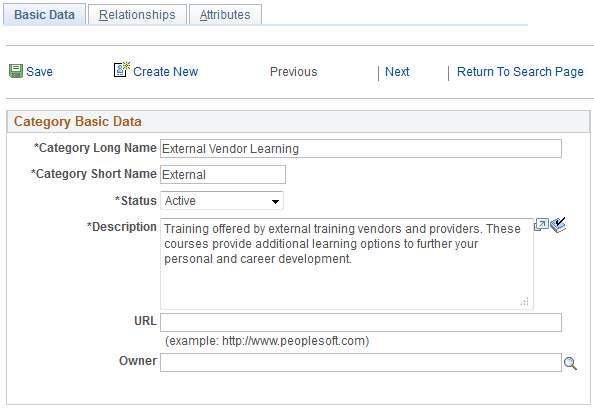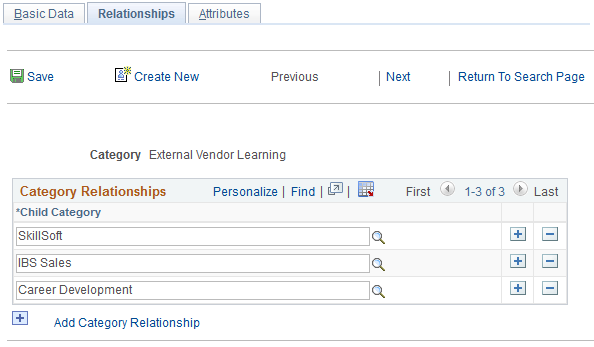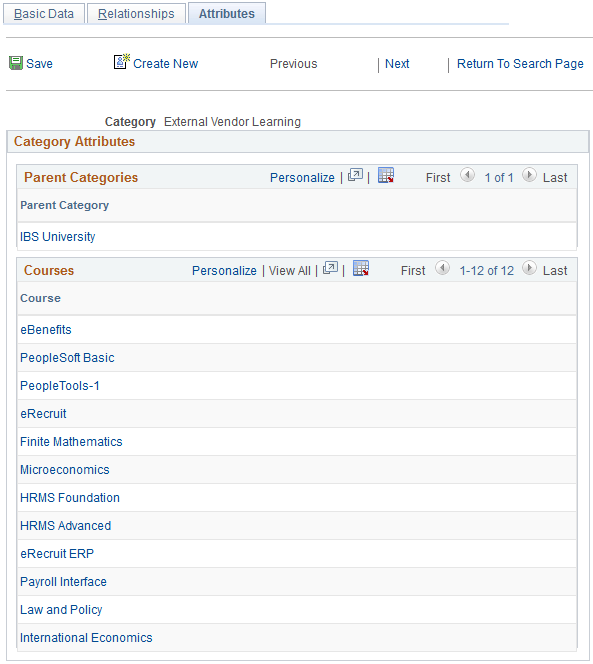Defining Learning Categories
To define learning categories, use the Maintain Categories (LM_CATG_LA_CMP) component.
|
Page Name |
Definition Name |
Usage |
|---|---|---|
|
LM_CATG_BSC_PG |
Define basic category information, such as name, description, status, and owner. |
|
|
LM_CATG_SECURTY_PG |
Define category relationships. |
|
|
LM_CATG_REL_LA_PG |
View a category's courses and parent categories. |
Categories enable you to classify courses and programs so that learners and managers can easily find appropriate learning in the catalog. When using the advanced search feature, users can search the catalog by category. Categories are also used when filtering the Find Learning page using the By Category facet.
Courses and programs can belong to multiple categories. For example, you might create separate insurance and manufacturing categories and include a risk management item in both. Categories can also be hierarchical: a manufacturing category might include logistics management and materials management subcategories. If you plan to create nested categories, it is more efficient to create the subcategories first.
Carefully plan the types of categories that you need, keeping in mind that categories, courses, classes, and programs can be shared across learning environments. Categories significantly impact the usability of your catalog because learners rely on categories to find offerings in the catalog. Therefore, be sure to define categories that make logical sense to your learners.
Note: (FRA) To make it easy for learners and administrators in France to find learning that qualifies for DIF (Droit Individuel à la Formation), consider creating one or more categories for DIF-eligible learning. Include DIF in the category name to facilitate searches. Alternatively, you might create a keyword called DIF and assign it to DIF-eligible courses.
See Updating the Catalog Indexes.
See Defining Keywords.
Use the Maintain Categories - Basic Data page (LM_CATG_BSC_PG) to define basic category information, such as name, description, status, and owner.
Navigation:
This example illustrates the fields and controls on the Maintain Categories - Basic Data page.

Note: When you create a category or change the long name and status of an existing category, you must rebuild the catalog index before the changes are reflected in the catalog search results.
See Updating the Catalog Indexes.
Field or Control |
Description |
|---|---|
Owner |
Select the person who has the main responsibility for this category. Typically, this is the administrator who is responsible for updating the category. The entry here is informational only—it does not determine who can update the category. |
Use the Maintain Categories - Relationships page (LM_CATG_SECURTY_PG) to define category relationships.
Navigation:
This example illustrates the fields and controls on the Maintain Categories - Relationships page.

Note: When you update the relationships for an existing category, you must rebuild the catalog index before the changes are reflected in the catalog search results.
See Updating the Catalog Indexes.
Category Relationships
Identify categories in the catalog that are subsets of this one. When users filter the Find Learning page by this category, the system also lists the subcategories that you identify here.
Field or Control |
Description |
|---|---|
Child Category |
Select the related category. You can select from any categories that are associated with your own learning environment. |
Use the Maintain Categories - Attributes page (LM_CATG_REL_LA_PG) to view a category's courses and parent categories.
Navigation:
This example illustrates the fields and controls on the Maintain Categories - Attributes page.

Parent Categories
This scroll area displays categories for which this category is a subcategory.
Courses
This scroll area displays the list of courses that belong to this category.